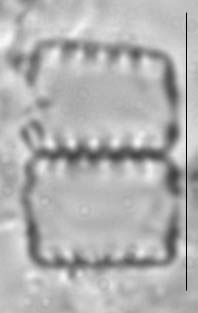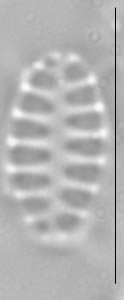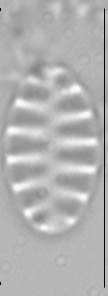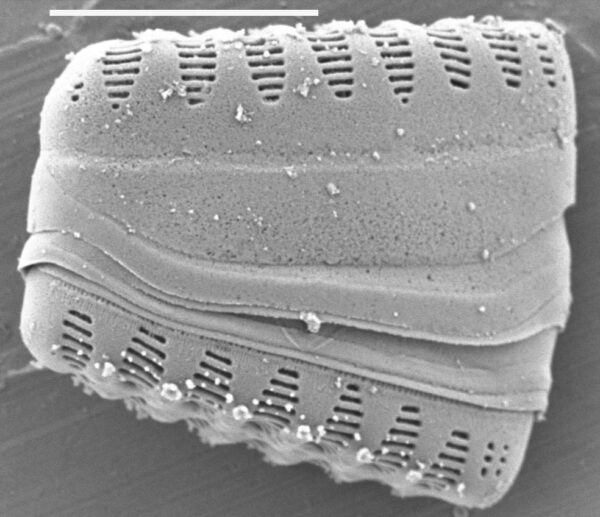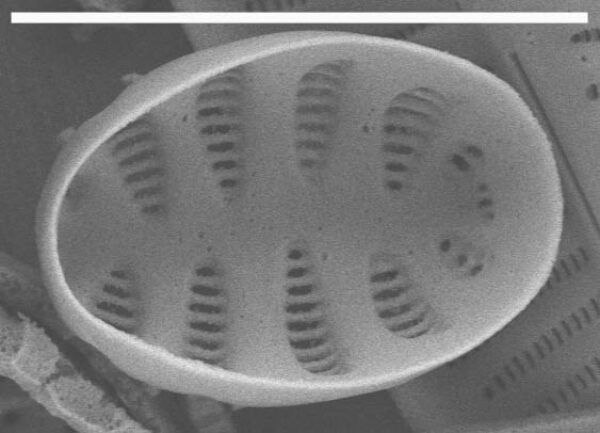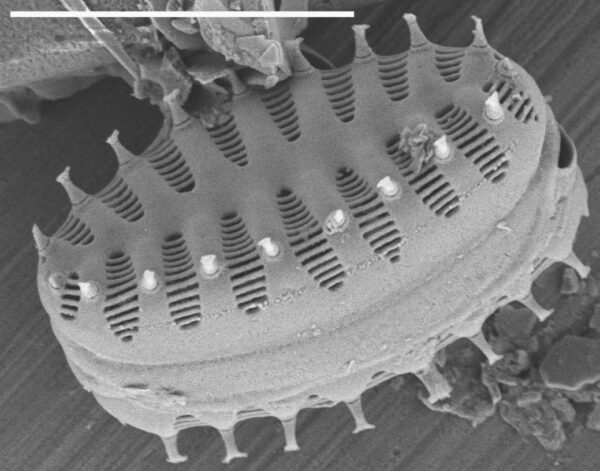Staurosirella pinnata
-
Category
-
Length Range4-10 µm
-
Width Range3-4 µm
-
Striae in 10 µm11-14
-
ContributorEduardo A. Morales - Oct 2010
-
ReviewerSam Rushforth - Aug 2013
Identification
Description
Valves are ovoid, 3-4 µm wide and 4-10 µm long with rounded ends. Valve face flat, or slightly undulate due to raised costae. In girdle view, frustules are rectangular and form ribbon-like colonies, joined by linking spines. Colonies are attached to the substratum at one end by a frustule with a a mucilage pad, or colonies may be planktonic. Axial area is linear to lanceolate. Striae are distinct, 11-14 in 10 µm. Lineolae are long forming wide striae . Striae vary from parallel in the valve center to radiate toward the valve ends. Striae extend onto the valve mantle. Costae are more slender than the striae. Spines are positioned on costae along the valve margin, except at the apices. Spines are conical at the base and spatulate towards the terminus. A single apical pore field with round poroids is present, displaced toward valve mantle. Girdle bands are open and do not bear perforations.
Samples collected from North America exhibit several morphological variants that are often included under the name Staurosirella pinnata. Since the type of this taxon has not been studied in detail, it is difficult to determine which of these variants corresponds to the “true” S. pinnata. We consider the specimens depicted in this page closely resemble the iconotype specimens presented by Ehrenberg (1843).
Autecology
-
Size Range, µm3
-
Motility
-
Attachment
-
Habitat
-
BCG
-
Waterbody
-
Distribution
- Learn more about this
Citations & Links
Citations
Links
-
Index Nominum Algarum
-
GenBank
-
North American Diatom Ecological DatabaseNADED ID: 175005
Cite This Page
Morales, E. (2010). Staurosirella pinnata. In Diatoms of North America. Retrieved April 26, 2024, from https://diatoms.org/species/staurosirella_pinnata
Responses
The 15 response plots show an environmental variable (x axis) against the relative abundance (y axis) of Staurosirella pinnata from all the stream reaches where it was present. Note that the relative abundance scale is the same on each plot. Explanation of each environmental variable and units are as follows:
ELEVATION = stream reach elevation (meters)
STRAHLER = distribution plot of the Strahler Stream Order
SLOPE = stream reach gradient (degrees)
W1_HALL = an index that is a measure of streamside (riparian) human activity that ranges from 0 - 10, with a value of 0 indicating of minimal disturbance to a value of 10 indicating severe disturbance.
PHSTVL = pH measured in a sealed syringe sample (pH units)
log_COND = log concentration of specific conductivity (µS/cm)
log_PTL = log concentration of total phosphorus (µg/L)
log_NO3 = log concentration of nitrate (µeq/L)
log_DOC = log concentration of dissolved organic carbon (mg/L)
log_SIO2 = log concentration of silicon (mg/L)
log_NA = log concentration of sodium (µeq/L)
log_HCO3 = log concentration of the bicarbonate ion (µeq/L)
EMBED = percent of the stream substrate that is embedded by sand and fine sediment
log_TURBIDITY = log of turbidity, a measure of cloudiness of water, in nephelometric turbidity units (NTU).
DISTOT = an index of total human disturbance in the watershed that ranges from 1 - 100, with a value of 0 indicating of minimal disturbance to a value of 100 indicating severe disturbance.
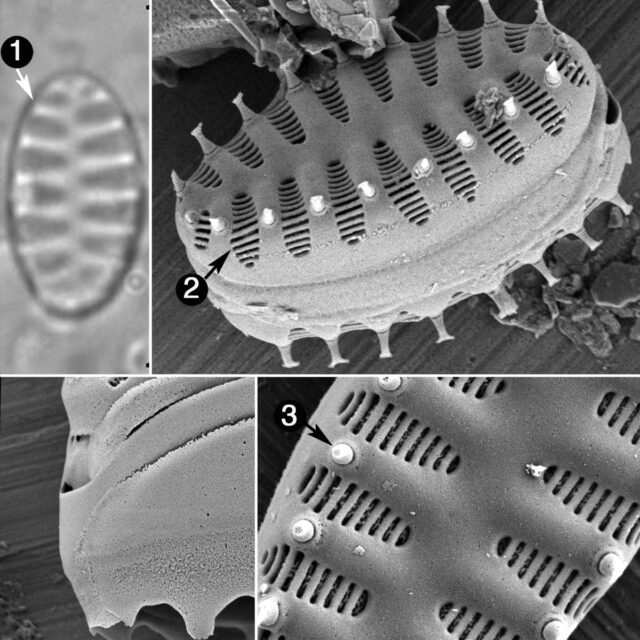
Staurosirella pinnata
- Valves oval
- Areolae lineolate
- Costae with spines
Striae are composed of pronounced lineolate areolae; costae are narrow. Solid spines are positioned on the costae. In the SEM, spines are conical at the base, becoming spatulate near the terminus. Porefields are absent. Girdle bands are open and lack perforations.
 Diatoms of North America
Diatoms of North America